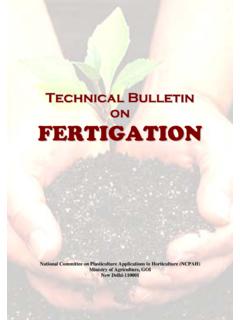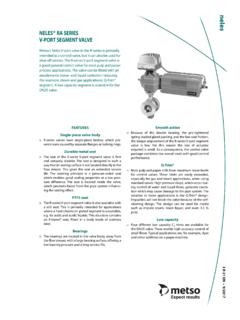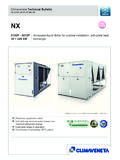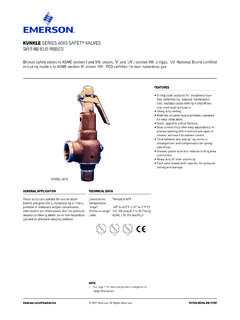Transcription of Technical Bulletin on FERTIGATION - ncpahindia.com
1 TTeecchhnniiccaall BBuulllleettiinn oonn FFEERRTTIIGGAATTIIOONN NNaattiioonnaall CCoommmmiitttteeee oonn PPllaassttiiccuullttuurree AApppplliiccaattiioonnss iinn HHoorrttiiccuullttuurree ((NNCCPPAAHH)) MMiinniissttrryy ooff AAggrriiccuullttuurree,, GGOOII NNeeww DDeellhhii--111100000011 National Committee on Plasticulture Applications in Horticulture (NCPAH) 11 Introduction India is poised to play a major role in increasing the utility of land water and other natural resources to compete with the increasing rate of population. Farmers today are faced with the challenge of meeting an ever-increasing demand for a wide range of high quality and safe foods. But these demands must be satisfied in economically viable ways whilst safeguarding natural resources and protecting the environment. Intensification of agriculture by irrigation and enhanced use of fertilizers may generate pollution by increased levels of nutrients in underground and surface waters.
2 Therefore judicious management of plant nutrients available through different fertilizers need be catered. A higher efficiency is possible with the help of pressurized irrigation system is placed around the plant roots uniformly and allow for rapid uptake of nutrients by the FERTIGATION is the technique of supplying dissolved fertilizer to crops through an irrigation system. Small applications of soluble nutrients saves labour, reduces compaction in the field, thereby enhancing productivity. Need for FERTIGATION Uneven growth in fertilizer consumption resulting in state-wise crop-wise variation in consumption. Mining of nutrients from the soil at alarming rate (soil fertility depletion due to inadequate and imbalanced fertilizer use). Decline in crop response to fertilizer Stagnation in fertilizer production. Weakening relationship between fertilizer use and foodgrain production Increasing dependence on fertilizer imports.
3 Fertilizers are chemical compounds (liquid or granular) which provides essential plant nutrients to the plants to promote growth. They are either applied through the soil or with irrigation water. FERTIGATION is method of applying fertilizers, soil amendments and other water soluble products required by the plant during its growth stages through drip /sprinkler irrigation system. National Committee on Plasticulture Applications in Horticulture (NCPAH) 22 Schematic View of Distribution of Plant Nutrients Advantages of FERTIGATION : 1. Increase in yield by 25-30% 2. Saving in fertilizers by 25-30% 3. Precise application and uniform distribution of fertilizers 4. Nutrient can be applied as per plant requirements 5. Acidic nature helps in avoiding clogging of drippers, it cleans drip system. 6. Minimizes nutrient losses. 7. Major & micro nutrients can be applied in one solution with irrigation.
4 8. Fertilizers can be injected as per required concentration 9. Saving in time, labour, energy 10. Light soils can be brought under cultivation. WWeetttteedd bbuullbb DDrriipp lliinnee NN == NNiittrrooggeenn,, KK == PPoottaassssiiuumm PP == PPhhoosspphhoorruuss,, ++ == MMiiccrroo eelleemmeennttss National Committee on Plasticulture Applications in Horticulture (NCPAH) 33 Fertilizers suitable for FERTIGATION S. No. Fertilizer N --- P --- K 1 Urea 46 0 0 2 Ammonium Nitrate 34 0 0 3 Ammonium Sulphate 21 0 0 4 Calcium Nitrate 16 0 0 5 Magnesium Nitrate 11 0 0 6 Urea Ammonium Nitrate 32 0 0 7 Potassium Nitrate 13 0 46 8 MAP 12 61 0 9 Potassium Chloride 0 0 60 10 Potassium Nitrate 13 0 46 11 Potassium Sulphate 0 0 50 12 Potassium Thiosulphate 0 0 25 13 MKP 0 52 34 14 Phosphoric Acid 0 52 0 15 NPK 19 19 19 20 20 20 Characteristics of Fertilizers suitable for FERTIGATION High nutrient content readily available to plants.
5 Fully water soluble at field temperature conditions. Fast dissolution in irrigation water. No clogging of filters and emitters. Low content of insolubles (< ). Minimum content of conditioning agents. Compatible with other fertilizers. Minimal interaction with irrigation water. No drastic changes of water pH ( < Ph > ). Low corrosives for control head and system. National Committee on Plasticulture Applications in Horticulture (NCPAH) 44 Solubility of Fertilizers: The quantity of fertilizer that can be dissolved in unit quantity of water is called the solubility. The solubility is greatly affected by the temperature variations. Normally these values are taken for 200 C. Types of fertilizers: a. Nitrogenous Fertilizers: These fertilizers are most commercially available and readily soluble in water and hence treated as good fertigating agents. Solubility of Nitrogenous Fertilizers Type of Fertilizer Nitrogen content ( % ) Solubility (gm /liter) Ammonium sulphate 21 750 Urea 46 1100 Ammonium nitrate 34 1920 Calcium nitrate 1290 Characteristic of Nitrogenous Fertilizers suitable for FERTIGATION Fertilizers Grade Formula pH (1 g/L at 20oC) Urea 46 0 0 CO(NH2)2 Potassium nitrate 13 0 46 KNO3 Only FERTIGATION grade Ammonium sulfate 21 0 0 (NH4)2SO4 Urea ammonium nitrate 32 0 0 CO(NH2)2.
6 NH4NO3 Ammonium nitrate 34 0 0 NH4NO3 Mono ammonium phosphate 12 61 0 NH4H2PO4 Calcium nitrate 15 0 0 Ca(NO3)2 Magnesium nitrate 11 0 0 Mg(NO3)2 b. Potassic fertilizers: Potassic fertilizers are best suited for FERTIGATION Solubility of Potassic Fertilizers Fertilizer K content ( % ) Solubility (gm /liter) Potassium sulphate 50 110 Potassium chloride 60 340 Potassium nitrate 44 133 National Committee on Plasticulture Applications in Horticulture (NCPAH) 55 Characteristics of Potassium Fertilizers suitable for FERTIGATION Fertilizers Grade Formula pH (1 gm / L at 20oC) Other nutrients Potassium chloride@ 0 0 60 KCl 46 % Cl Potassium nitrate 13 0 46 KNO3 13 % N Potassium sulfate# 0 0 50 K2SO4 18 % S Potassium Thiosulphate* 0 0 25 K2S2O3 - 17 % S Monopotassium phosphate 0 52 34 KH2PO4 52 % P2O5 @ Only White # Only FERTIGATION grade * Liquid c.
7 Phosphatic fertilizers: P+Ca=Calcium phosphate (insoluble) P+Ammonium+Magnesium=Magnesium ammonium phosphate(Insoluble) P+Iron=Iron phosphate (insoluble) Even good P sources like poly phosphates gets precipitated if Ca+Mg in water is >50 ppm and Bicarbonate>150ppm. If Bicarbonate content is <100ppm, the Ca+ Mg content can go upto 75ppm Characteristics of Phosphorus Fertilizers suitable for FERTIGATION Fertilizers Grade Formula pH (1 g/L at 20oC) Phosphoric acid 0 52 0 H3PO4 Mono-potassium phosphate 0 52 34 KH2PO4 Mono ammonium phosphate 12 61 0 NH4H2PO4 Micronutrients: are elements which are essential for plant growth which are required in smaller amounts than primary nutrients such as N, P and K. Solubility of Micronutrient Fertilizers Fertilizer Content ( % ) Solubility (gm / liter) Solubor 20 B 220 Copper sulphate 25 Cu 320 Iron sulphate 20 Fe 160 Magnesium sulphate 10 710 Ammonium molybdate 54 430 Zinc sulphate 36 965 Manganese sulphate 27 1050 National Committee on Plasticulture Applications in Horticulture (NCPAH) 66 Compatibility: Mixing the solutions of two or more than two water soluble fertilizers can sometimes result in the formation of a precipitate.
8 Their solutions should be prepared in two separate tanks. Interaction between fertilizers nutrients - Compatibility When preparing fertilizer solutions for FERTIGATION , the solubility product of the different materials must be taken into consideration. Fertilizers mixtures in the tank which reduce the solubility of the mixture due to formation of precipitates: a) Calcium nitrate with any sulfates = formation of CaSO4 precipitate (gypsum) Ca(NO3)2 + (NH4)2SO4 CaSO4 + .. b) Calcium nitrate with any phosphates = formation of Ca phosphate precipitate Ca(NO3)2 + NH4H2PO4 CaHPO4 + .. c) Magnesium with mono- ammonium phosphate = formation of magnesium phosphate precipitate Mg(NO3)2 + NH4H2PO4 MgHPO4 + .. d) Ammonium sulfate with KCl or KNO3: formation of K2SO4 precipitate SO4(NH4)2 + KCl or KNO3 K2SO4 + .. e) Phosphorus with iron = formation of iron phosphates precipitate Compatibility chart for different water soluble fertilizers Fertilizers Urea Ammonium Nitrate Ammonium Sulphate Calcium Nitrate Mono Ammonium Phosphate Mono Potassium Phosphate Potassium Nitrate Urea C C C C C C Ammonium Nitrate C C C C C C Ammonium Sulphate C C LC C C LC Calcium Nitrate C C LC NC NC C
9 Mono Ammonium Phosphate C C C NC C C Mono Potassium Phosphate C C C NC C C Potassium Nitrate C C L C C C C- Compatible, NC = Not Compatible LC = Limited compatible National Committee on Plasticulture Applications in Horticulture (NCPAH) 77 Fertilizer Evaluation for Suitability to FERTIGATION Property NH4NO3 (NH4)2SO4 K2SO4 KCl KNO3 H3PO4 MAP Solubility High Medium Low Medium Medium High Medium Precipitation Low High High Low Low Low High Compatibility Good Poor Poor Medium Medium Medium Good Corrosion Medium Poor Poor Poor Good Poor Medium Cooling Effect on Dissolution: Some fertilizers specially, cool down the temperature of water during dissolution resulting in reduced solubility of the fertilizer.
10 The fertilizers resulting in lowering the water temperature are urea, ammonium nitrate, calcium nitrate and potassium nitrate. Chemical Aspects of FERTIGATION 1. Solubility limits of the least soluble salt in solution 2. Precipitation of Ca-Mg/P compounds: a) Clogging of drippers and filters b) Less nutrient availability 3. Corrosivity Corrosivity of Fertilizers Kind of metal Ca(NO3)2 (NH4)2SO4 NH4NO3 Urea H3PO4 DAP Galvanized iron 2 4 4 1 4 1 Sheet aluminium No 1 1 No 2 2 Stainless steel No No No No 1 No Bronze 1 3 3 No 2 4 Brass 1 2 3 No 2 4 No = None; 1 = Slight; 2 = Moderate; 3 = Considerable; 4 = Severe Fertilizer solubility and compatibility Fertilizers a.





